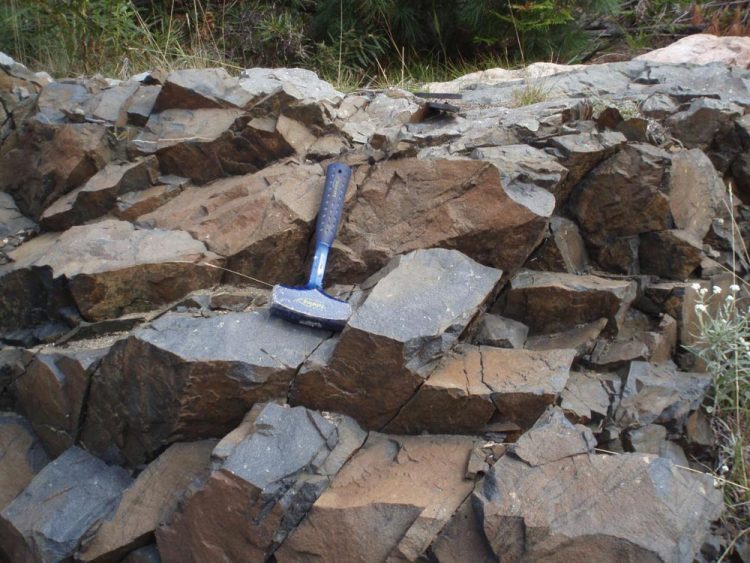'Tiny clocks' crystallize understanding of meteorite crashes

This rocky outcrop at Sudbury is where the crystals of baddeleyite came from -- crystals that are now being used in a new technology to help date when meteorite strikes took place. Photo by Desmond Moser/Western University
Almost two billion years ago, a 10-kilometre-wide chunk of space slammed down into rock near what is now the city of Sudbury. Now, scientists from Western University and the University of Portsmouth are marrying details of that meteorite impact with technology that measures surrounding crystal fragments as a way to date other ancient meteorite strikes.
The pioneering technique is helping add context and insight into the age of meteor impacts. And ultimately, it provides new clues into the beginnings of life on this planet and others, said Desmond (Des) Moser, associate professor in the Departments of Earth Sciences and Geography at Western.
“The underlying theme is, when did life begin? We know that it couldn't happen as long as the surface was being periodically vaporized by meteorite strikes during the solar system's early years and youth — so if we can figure out when those strikes stopped, we can then understand a bit more about how we got here, and when.”
In this instance, researchers have been able to use new imaging techniques to measure the atomic nanostructure of ancient crystals at impact locations, using the 150-kilometre-wide crater at Sudbury as a test site.
Shock waves from that meteorite impact deformed the minerals that made up the rock beneath the crater, including small, tough crystals that contain trace amounts of radioactive uranium and lead. “These can be used as tiny clocks that are the basis for our geologic time scale,” Moser said. “But because these crystals are a banged-up mess, conventional methods won't help in extracting age data from them.”
An international team using specialized instruments at Western's Zircon and Accessory Phase Laboratory (ZAPLab) and a new instrument called the atom probe, at CAMECA Laboratories in the US, have made that job easier. With the probe, researchers are able to slice and lift out tiny pieces of crystal baddeleyite which is common in terrestrial, Martian and lunar rocks and meteorites.
Then Moser's team — including researcher Lee White and co-supervisor James Darling of the University of Portsmouth — measured the deformation in the crystals after sharpening and polishing the pieces into extremely fine needles, then evaporated and identified the atoms and their isotopes layer by layer. The result is a 3D model of the atoms and their positions.
“Using the atom probe to go from the rock to the crystal to its atomic level is like zooming in with the ultimate Google Earth,” Moser says. This atomic-scale approach holds great potential in establishing a more accurate chronology of the formation and evolution of planetary crusts.
The team's findings are published in the journal Nature Communications.
###
MEDIA CONTACT: Debora Van Brenk, Media Relations Officer, Western University, 519-661-2111 x85165, or on mobile at 519-318-0657 and deb.vanbrenk@uwo.ca
ABOUT WESTERN: Western University delivers an academic experience second to none. Since 1878, The Western Experience has combined academic excellence with life-long opportunities for intellectual, social and cultural growth in order to better serve our communities. Our research excellence expands knowledge and drives discovery with real-world application. Western attracts individuals with a broad worldview, seeking to study, influence and lead in the international community.
Media Contact
All latest news from the category: Earth Sciences
Earth Sciences (also referred to as Geosciences), which deals with basic issues surrounding our planet, plays a vital role in the area of energy and raw materials supply.
Earth Sciences comprises subjects such as geology, geography, geological informatics, paleontology, mineralogy, petrography, crystallography, geophysics, geodesy, glaciology, cartography, photogrammetry, meteorology and seismology, early-warning systems, earthquake research and polar research.
Newest articles

NASA: Mystery of life’s handedness deepens
The mystery of why life uses molecules with specific orientations has deepened with a NASA-funded discovery that RNA — a key molecule thought to have potentially held the instructions for…

What are the effects of historic lithium mining on water quality?
Study reveals low levels of common contaminants but high levels of other elements in waters associated with an abandoned lithium mine. Lithium ore and mining waste from a historic lithium…

Quantum-inspired design boosts efficiency of heat-to-electricity conversion
Rice engineers take unconventional route to improving thermophotovoltaic systems. Researchers at Rice University have found a new way to improve a key element of thermophotovoltaic (TPV) systems, which convert heat…



